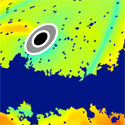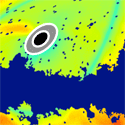Collisions on the sky
A rapid expansion of the early universe—cosmological inflation—offers the best explanation so far of what astronomers observe. One flavor of this concept, called eternal inflation, involves nucleation of bubble universes (one of which we are in) in a continually inflating background. The collection of bubbles is known as the multiverse. Many aspects of this model would be difficult, if not impossible, to test, but one approach is to look for imprints of bubble behavior in the cosmic microwave background radiation. In a paper in Physical Review Letters, and a longer technical exposition in Physical Review D, Stephen Feeney at University College London and his colleagues analyze seven years of cosmic microwave background data from the Wilkinson Microwave Anisotropy Probe (WMAP) to hunt for signatures of eternal inflation.
The authors zeroed in on what might be the best target of opportunity, namely the effects of bubble collisions. Although direct observation of other bubble universes is not possible, the bubbles might have collided with one another and this bashing together might have left imprints on the cosmic microwave background, essentially itself a palimpsest of cosmic history. Feeney et al. carry out a statistical analysis of the full sky WMAP data, searching for specific distortions that may have been the wreckage of bubble crashes. They find no signatures of collisions, but are able to use this null result to put an upper limit on the number of bubble collisions the theory could predict and still be consistent with the data. The hope now is to continue the search for eternal inflation by applying the same tests to better data expected from the Planck satellite, which was launched in 2009. – David Voss





